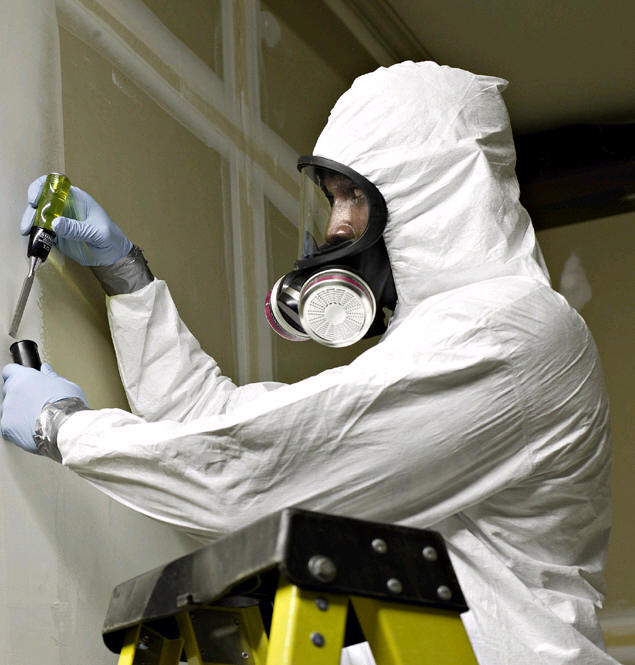Asbestos Testing: Essential Steps for a Safe Living Environment
Wiki Article
The Total Process of Accredited Asbestos Checking to Make Sure Home Conformity
In the world of home administration and compliance, the procedure of recognized asbestos testing stands as an essential component to ensure the safety and security and health of passengers. From the preliminary analysis to the final analysis of outcomes, each stage plays an essential duty in identifying the existence of asbestos within a residential or commercial property.Accredited Asbestos Testing: First Analysis
In carrying out the first evaluation for accredited asbestos screening, a meticulous assessment of the residential or commercial property's materials is crucial to accurately determine possible asbestos-containing materials. Unique focus is provided to products that are vulnerable to harm or disruption, as these scenarios can launch harmful asbestos fibers into the air.Recognized asbestos assessors comply with stringent protocols established by regulative bodies to guarantee the accuracy and dependability of the testing process. By diligently recording searchings for and using sophisticated testing approaches, assessors can give homeowner with an extensive record outlining the existence of asbestos, if any, and the recommended actions for reduction or elimination. This first analysis sets the foundation for succeeding activities to deal with asbestos concerns and guarantee the security and compliance of the residential or commercial property.
Sample Collection Treatments for Asbestos Checking
Reliable sample collection treatments are necessary in guaranteeing exact asbestos testing outcomes and conformity with regulative criteria. When gathering examples for asbestos testing, it is critical to comply with rigorous protocols to decrease the risk of contamination and make sure the reliability of the outcomes.
To start with, it is very important to identify the presumed asbestos-containing materials (ACMs) and prioritize tasting locations based on aspects such as the product's condition, availability, and potential for disturbance. Asbestos Testing. Examples need to be collected from different areas within the residential or commercial property to supply a comprehensive evaluation of asbestos existence
Throughout sample collection, accredited experts need to wear suitable individual safety tools (PPE) to safeguard against asbestos direct exposure. They have to make use of clean tools, such as disposable gloves and plastic sheet, to stop cross-contamination between samples. Samples should be thoroughly gathered utilizing a defined strategy, such as damp cleaning or coring, and firmly secured in airtight containers to preserve their integrity during transportation to the research laboratory for evaluation.
Research Laboratory Evaluation Refine for Asbestos Examples
Upon completion of the sample collection process, the asbestos examples are diligently transported to certified labs for thorough evaluation. The initial action in the research laboratory evaluation procedure is example prep work, where the accumulated examples are meticulously refined to draw out the asbestos fibers.
As soon as the analysis is complete, an in-depth report is produced, laying click reference out the searchings for and confirming whether asbestos exists, the kind of asbestos fibers recognized, and the concentration degrees. This info is vital for building owners to take the required steps to ensure conformity with asbestos guidelines and safeguard the health and wellness of residents.

Coverage and Interpretation of Asbestos Test Outcomes
Accredited asbestos screening research laboratories provide in-depth records that offer vital understandings into the presence, type, and focus degrees of asbestos fibers located in samples collected from buildings. These records are important for homeowner and supervisors to understand the risk positioned by asbestos and make notified choices concerning its monitoring or elimination. The records commonly consist of information on the methods used for testing, the locations from which samples were taken, the kind of asbestos identified (such as chrysotile, amosite, or crocidolite), and the concentration degrees of asbestos fibers detected.Interpreting these results requires knowledge to evaluate the prospective health and wellness risks associated with asbestos exposure, determine the appropriate strategy, and make certain governing conformity (Asbestos Testing). Depending upon the findings, recommendations may vary from proceeded tracking and maintenance to encapsulation or complete asbestos reduction. Building proprietors must very carefully evaluate these reports and talk to asbestos specialists to establish an extensive plan for resolving any kind of asbestos problems identified
Making Certain Building Conformity With Asbestos Regulations
To keep adherence with asbestos laws, residential property owners have to carefully execute actions to make sure compliance with relevant legislations and standards. This consists of conducting routine asbestos inspections by approved specialists web to determine any existence of asbestos-containing materials within the property. When asbestos is identified, homeowner need to follow asbestos monitoring plans that synopsis appropriate control, removal, or encapsulation treatments to stop exposure and spread of asbestos fibers. Conformity also includes maintaining detailed documents of asbestos screening, maintenance, and elimination activities for assessment purposes.Residential or commercial property owners must supply asbestos awareness training to employees and residents to lessen the threat of asbestos direct exposure and ensure appropriate handling of materials that might consist of asbestos. Additionally, it is essential to stay notified about any type of updates or adjustments in asbestos regulations to adjust management practices appropriately. By proactively dealing with asbestos compliance demands, homeowner can create a safe atmosphere for passengers and alleviate Resources prospective lawful and health and wellness risks associated with asbestos direct exposure.
Conclusion
Finally, accredited asbestos screening is an important process for ensuring home conformity with policies. The initial evaluation, sample collection procedures, laboratory evaluation, and analysis of results are all important actions in this procedure. By following these procedures, homeowner can recognize and deal with any kind of asbestos dangers present, shielding the health and wellness of passengers and maintaining conformity with regulatory needs.Report this wiki page